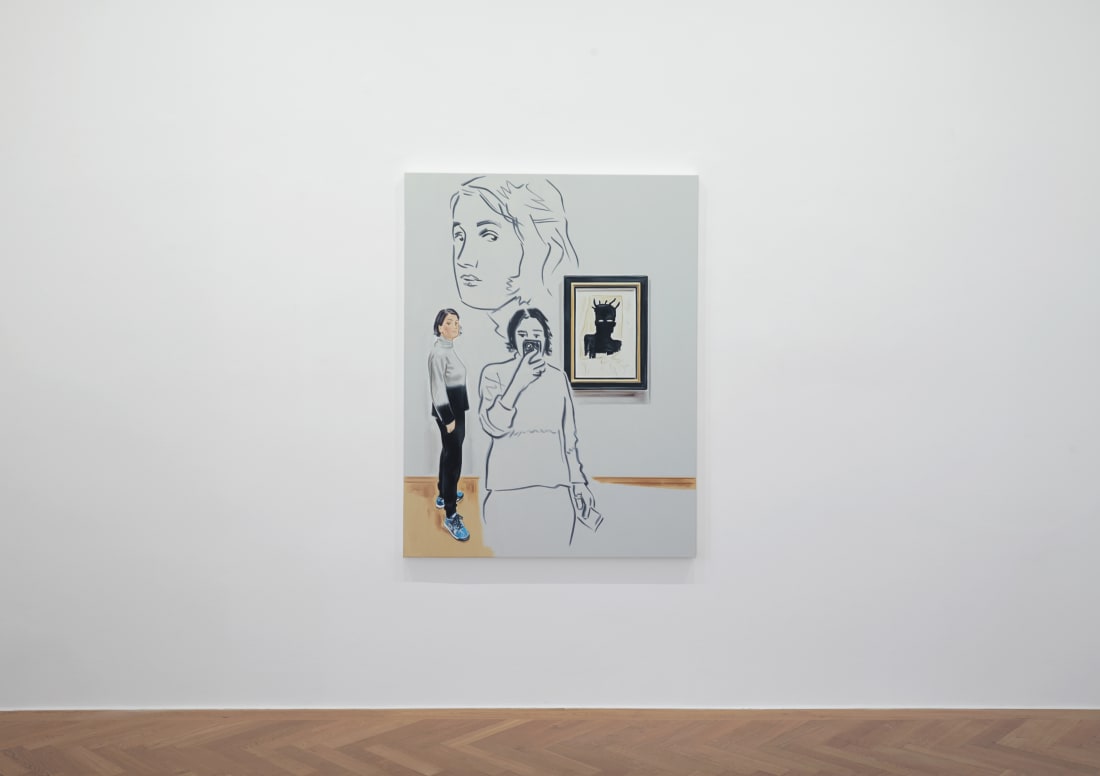Overview
This exhibition presents new paintings by Marcin Maciejowski, highlighting the Polish artist’s continued exploration of the often-overlooked moments of everyday life and urban culture. Contemporary scenes are shown alongside works that reference prominent artists of the past – or their artworks – including Kazimir Malevich and Pablo Picasso. Ranging from present-day moments to depictions of artworks from various periods of art history, Maciejowski’s paintings reveal both a strong fascination with the past as well as a desire to engage with the discourse of today, of which he himself is a part. The artist sources his imagery from a variety of media, including his own photographs, capturing moments in time that range from the seductive to the mundane.
Maciejowski combines a graphic, comic-book aesthetic with realism to present an enigmatic form of social commentary. By using a palette that seems almost nostalgic and does not differentiate between the historic and current events, these varied works – shown side by side – achieve a certain timelessness. Paintings executed in black-and-white are further reminiscent of archival or documentary material. They seem to preserve a subject or an impression, but at the same time, Maciejowski detaches the original from its temporal context. The framing of the image and viewpoint it presents to the viewer is selected by the artist to accentuate this disconnect or sense of uncertainty. In Basquiat Documentary (YouTube) (2023), for instance, the strong closeup view enhances the composition’s ambiguity by compromising its legibility.
In his painting Polish Cinema (Polanski 1961) (2023), Maciejowski depicts a film still from Roman Polanski’s Academy Award-nominated Knife in the Water. He draws attention to the act of looking by granting the viewer of the painting the same perspective of a woman changing her clothes as that sought out by the voyeuristic young man in the film. Maciejowski’s selection of this specific scene highlights the troubled social dynamics encapsulated in the film, evidenced in a narrative marked by human desire and dark fantasies – issues that are only further reinforced by the criminal allegations made against the Polish-French filmmaker himself. Similar themes, such as the power relations implicit in this act of image appropriation, are taken up in another painting depicting the actress Sharon Stone in front of a work by Malevich. Here, the embedded caption, a frequent addition in Maciejowski’s works, disturbs the illusionary character of the painting while referencing the sensationalism of the art market – a part of the art world that Maciejowski frequently highlights in his paintings.
The work Yves Saint-Laurent (2023) shows a cropped image of a fashion model walking towards the viewer, presumably taken on a runway. The motif stems from a Polish fashion magazine from the 1990s and in the bottom left corner the image is prominently captioned with the designer’s name. For his rendering of the clothes’ fabric, the artist drew on sculptural forms, specifically on Michelangelo’s Madonna della Pietà (1498–1499), creating a ‘sculptural form on canvas,’ as he explains. By incorporating this art historical reference into this composition, Maciejowski plays with ubiquitous pathos formulas that have been valid for centuries.
For Wife as (Jan) van Eyck (2023), the artist reinterprets the universally revered self-portrait by the titular painter in an act of substitution that replaces the artist with a depiction of Maciejowski’s own wife. The work highlights the artist’s central theme of the role of women in art and raises a more general issue of representation of gender in society. He translocates the original composition by Jan van Eyck (1390–1441) into a contemporary dialogue and thus questions how the canon of art history has shaped today’s understanding of representation and identity construction. As for all works in the exhibition, the social and political implications of Maciejowski’s subject are retained in his painted versions. They are brought into stark focus through the change in medium, in a sense creating a new reality for these universal codes of mass culture.
Watch a video of the exhibition


















































































































































































